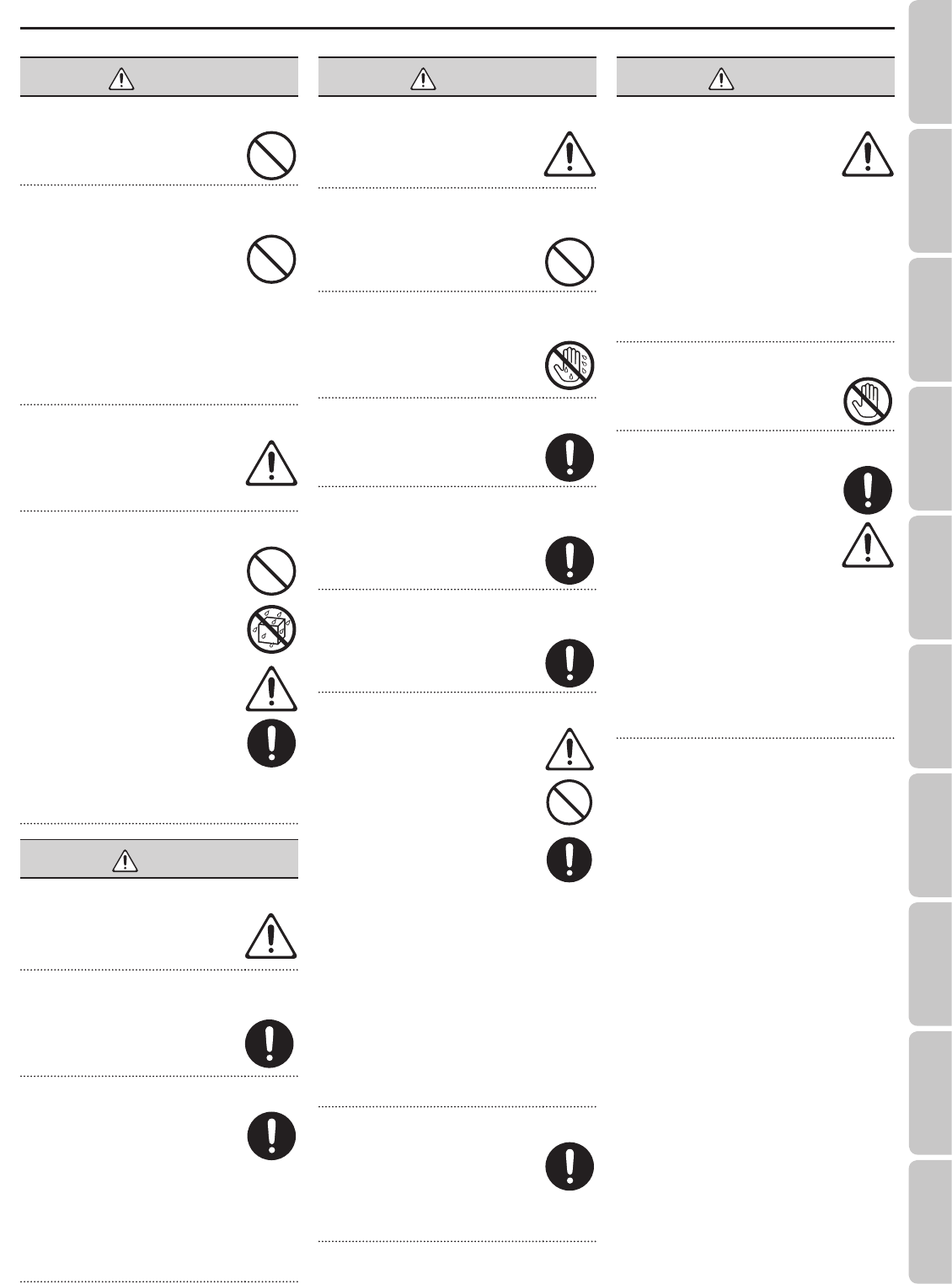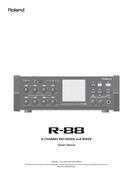
USING THE UNIT SAFELY
3
Overview Quick Guide Getting Ready IN/OUT/Monitor
Recording/Playback
Mixer Timecode File Operation USB Appendix
WARNING
Do not drop or subject to strong impact
Protect the unit from strong impact.
(Do not drop it!)
Do not share an outlet with an unreasonable number
of other devices
Do not force the unit’s power-
supply cord to share an outlet with
an unreasonable number of other
devices. Be especially careful when
using extension cords—the total
power used by all devices you have
connected to the extension cord’s
outlet must never exceed the power
rating (watts/amperes) for the
extension cord. Excessive loads can
cause the insulation on the cord to
heat up and eventually melt through.
Do not use overseas
Before using the unit in a foreign
country, consult with your retailer, the
nearest Roland Service Center, or an
authorized Roland distributor, as listed
on the “Information” sheet
Handle batteries carefully
• Batteries must never be recharged,
heated, taken apart, or thrown into
re or water.
• Never expose batteries to excessive
heat such as sunshine, re or the like.
• Incorrect handling of batteries,
rechargeable batteries, or a
battery charger can cause leakage,
overheating, re, or explosion.
Before use, you must read and
strictly observe all of the precautions
that accompany the batteries,
rechargeable batteries, or battery
charger.
• When using rechargeable
batteries and a charger, use only
the combination of rechargeable
batteries and charger specied by
the battery manufacturer.
CAUTION
Place in a well ventilated location
The unit and the AC adaptor should
be located so their location or position
does not interfere with their proper
ventilation.
When disconnecting an AC adaptor, grasp it by the
plug
To prevent conductor damage, always
grasp the AC adaptor by its plug when
disconnecting it from this unit or from
a power outlet.
Periodically clean the AC adaptor’s plug
At regular intervals, you should
unplug the AC adaptor and clean
it by using a dry cloth to wipe all
dust and other accumulations away
from its prongs. Also, disconnect the
power plug from the power outlet
whenever the unit is to remain unused
for an extended period of time. Any
accumulation of dust between the
power plug and the power outlet can
result in poor insulation and lead to
re.
CAUTION
Manage cables for safety
Try to prevent cords and cables from
becoming entangled. Also, all cords
and cables should be placed so they
are out of the reach of children.
Avoid climbing on top of the unit, or placing heavy
objects on it
Never climb on top of, nor place heavy
objects on the unit.
Do not connect or disconnect the AC adaptor with wet
hands
Never handle the AC adaptor or its
plugs with wet hands when plugging
into, or unplugging from, an outlet or
this unit.
Disconnect everything before moving the unit
Before moving the unit, disconnect
the AC adaptor and all cords coming
from external devices.
Unplug the AC adaptor from the outlet before
cleaning
Before cleaning the unit, turn it o
and unplug the AC adaptor from the
outlet (p. 24).
If there is a possibility of lightning strike, disconnect
the AC adaptor from the outlet
Whenever you suspect the possibility
of lightning in your area, disconnect
the AC adaptor from the outlet.
Handle batteries carefully
If used improperly, batteries may
explode or leak and cause damage
or injury. In the interest of safety,
please read and observe the following
precautions (p. 23).
• Carefully follow the installation
instructions for batteries, and
make sure you observe the correct
polarity.
• Avoid using new batteries together
with used ones. In addition, avoid
mixing dierent types of batteries.
• Remove the batteries whenever
the unit is to remain unused for an
extended period of time.
• Never keep batteries together with
metallic objects such as ballpoint
pens, necklaces, hairpins, etc.
• Used batteries must be disposed
of in compliance with whatever
regulations for their safe disposal
that may be observed in the region
in which you live.
Handle the ground terminal carefully
If you remove the screw from the
ground terminal, be sure to replace
it; don’t leave it lying around where
it could accidently be swallowed by
small children. When refastening the
screw, make that it is rmly fastened,
so it won’t come loose.
CAUTION
Precautions concerning use of phantom power supply
Always turn the phantom power o
when connecting any device other
than condenser microphones that
require phantom power. You risk
causing damage if you mistakenly
supply phantom power to dynamic
microphones, audio playback devices,
or other devices that don’t require
such power. Be sure to check the
specications of any microphone
you intend to use by referring to the
manual that came with it.
(This instrument’s phantom power: 48 V DC, 10
mA per channel)
Take care not to get burned
Batteries may reach a high
temperature; please be careful to
avoid burning yourself.
Handle leaking batteries carefully
• If uid has leaked from a battery,
make sure not to touch it with your
bare hands.
• If any of the leaking uid gets
into your eyes, the loss of vision
may result. Do not rub your eyes;
use clean water to ush them
thoroughly. Then, promptly see a
doctor.
• Burning of the skin or dermatitis may
result if uid has gotten onto your
skin or clothing. Use clean water
to ush aected areas thoroughly;
then, promptly see a doctor.
• Using a soft cloth, carefully wipe
any remaining uid from the inside
of the battery compartment. Then,
install new batteries.
































